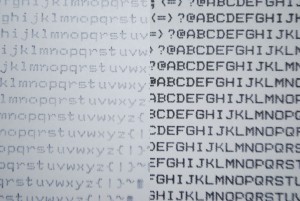Improve Print Quality and Print Density – Ink

One of the most common marking related problems that manufacturers encounter is how to increase or maintain print density over a given number of applications.
Print density is the measure of light reflected off of the press sheet. In laymen’s terms this is how light or dark the print appears on the substrate to which it is applied. Print density will begin to degrade over a period of time from multiple print strikes, thus negatively affecting the overall print quality of the image. It is important to know at what stage one can expect to see a decrease in print density. Monitoring print density and conversely marking quality is critical in several factors from ensuring a product is used safely to ensuring individual components are shipped to the correct location.
Why Your Substrate Matters
There are two primary substrate related factors to consider when evaluating the print density of your marking application. These factors are:
Substrate Porosity: the greater the porosity (number of holes in a substrate) the greater the fade (bleeding of ink on the print edges) will be on the final print, and thus the greater the reduction in overall print density.
Substrate Surface Tension: the relationship between surface tension and surface energy (wetting tension) varies greatly between oilborne formulations and waterborne formulations. Oilborne formulations, with their naturally lower surface tension, will generally adhere to most surfaces. Waterborne formulations, with naturally higher surface tension, require alcohols or surfactants to achieve the desire level of transfer. This is critical to print quality as the surface tension of the inks being used must be lower then the wetting tension of the substrate to which the inks are being applied in order to achieve a high print density.
Improving Print Density
When formulating the correct solution to your print density needs, not only must the specific attributes of your substrate be accounted for, but you must also consider the properties of the marking ink that will be used. The creation of a custom ink that matches the substrate needs of a specific marking application involves the precise combination of various elements.
Choosing The Right Solvents
The proper formulation of a substrate specific ink involves reviewing and accounting for waterborne or oilborne formulas that maintain or exceed the desired parameters of the application. This requires the specific combination of solvents needed to match the surface tension printing needs of the target substrate.
Choosing The Right Vehicles
In addition to making sure that the optimal solvent is used, it is also important to consider the viscosity of the ink in relation to the vehicle being used to meter the ink. Viscosity is the ink’s internal resistance to flow and the higher an ink’s viscosity the slower it’s absorption and the sharper the print. A higher viscosity also tends to reduce misting of the ink, but can lead to blotchy prints if the viscosity is too high. Matching an ink’s viscosity to the metering application used will help to ensure the desired level of print density.
Choosing The Right Dyes & Pigments
In some cases the simplest solution is often the most appropriate. By evaluating the dyes and pigments used in an ink one can make alterations to increase the print density. Analyzing dyes and/or pigments used in the creation of an ink in relation to the printing surface will help to ensure print density by creating the desired level of contrast in the print. In many cases adding more pigment to the ink solution can enhance the contrast of a print and thus the quality of the print density.
Adequately solving print density problems in manufacturing marking applications requires a multi-faceted approach that looks at the problem from a holistic view. Given that an unsatisfactory level of print density can lead to lost revenue, productivity and even injury, it is important to ensure that you maintain a high level of print density throughout the life cycle of your marking application.
